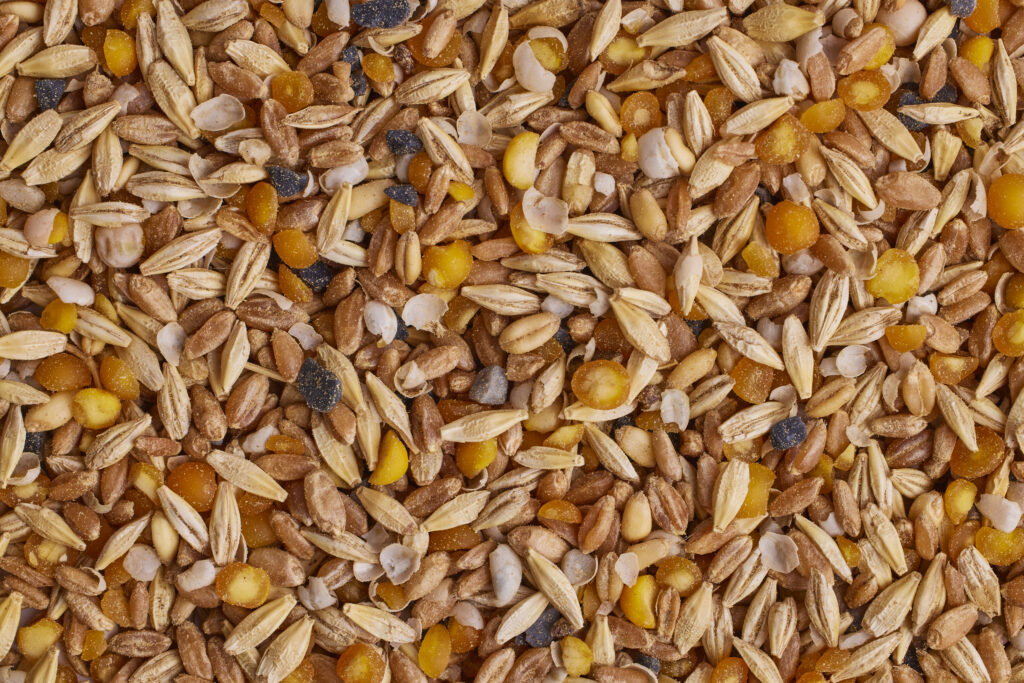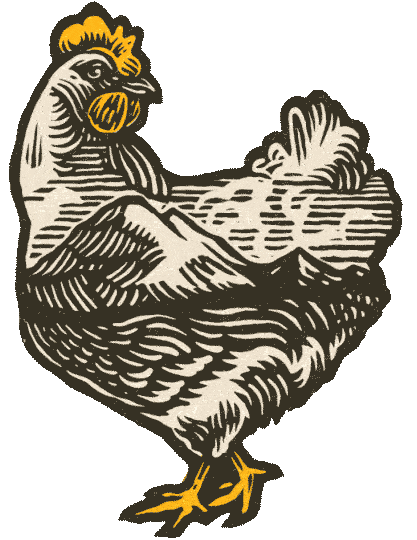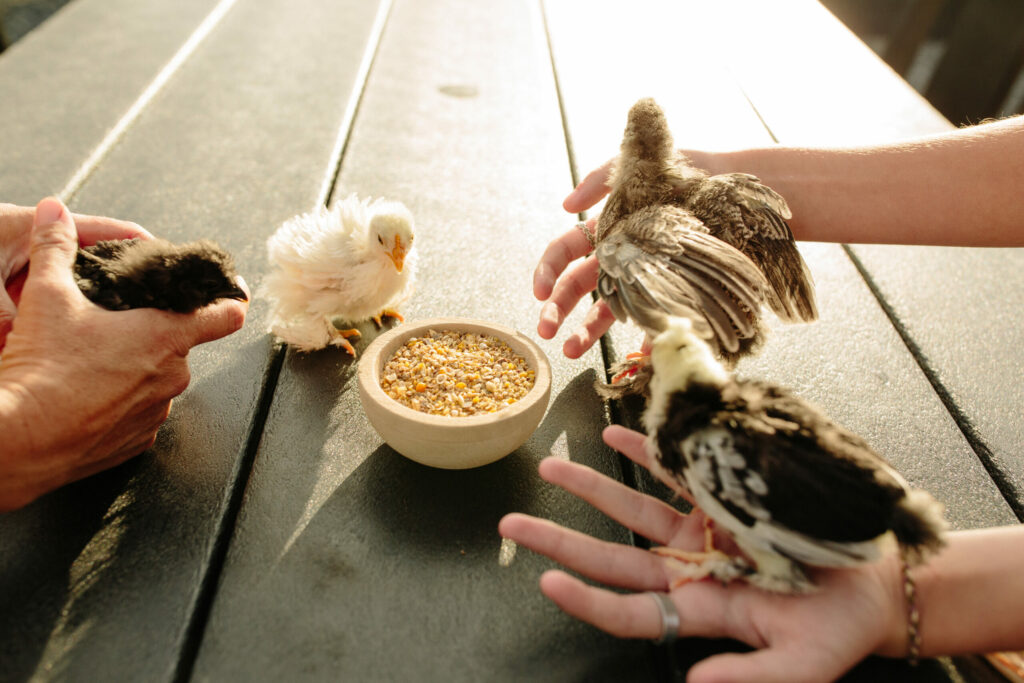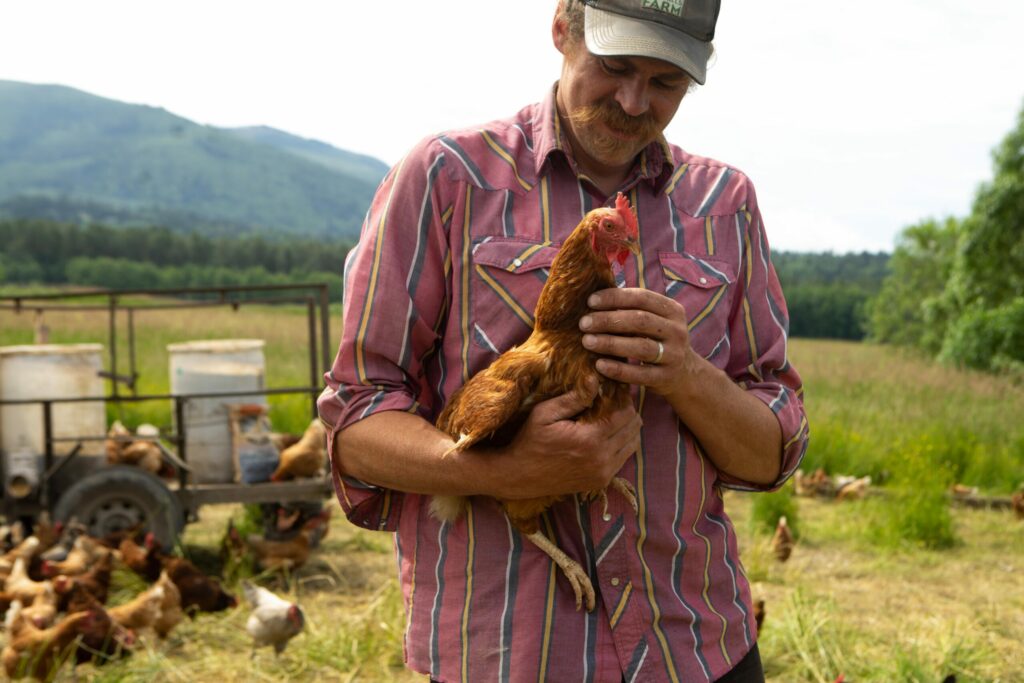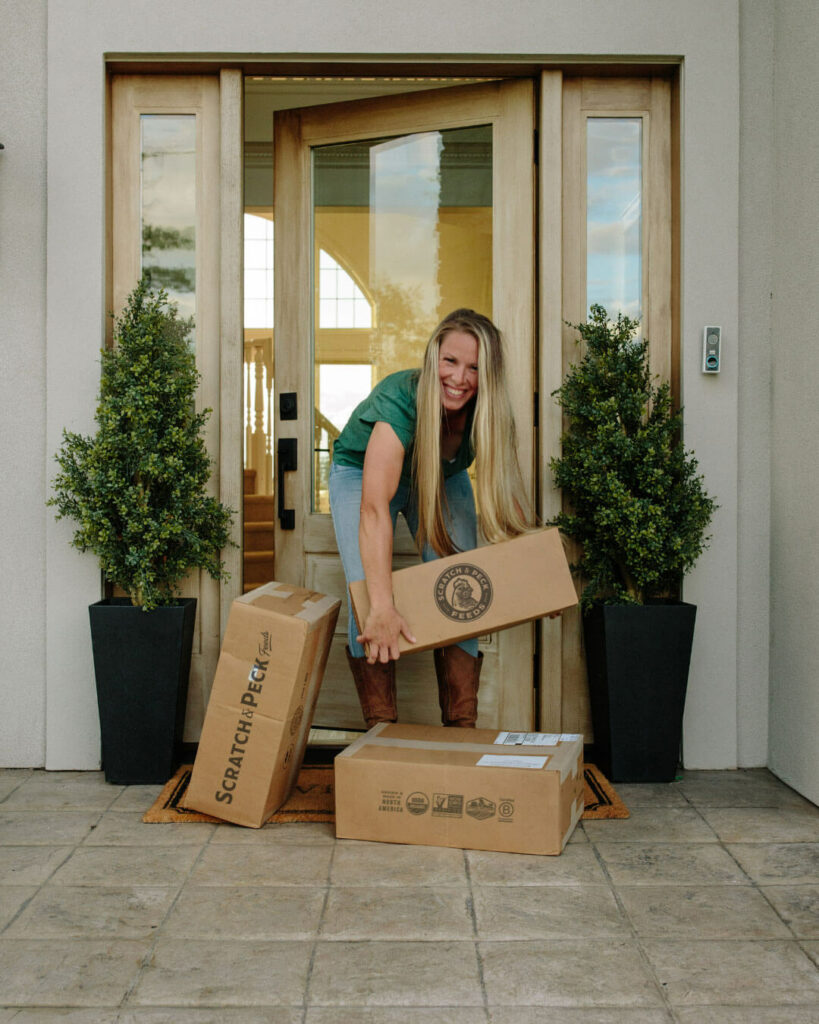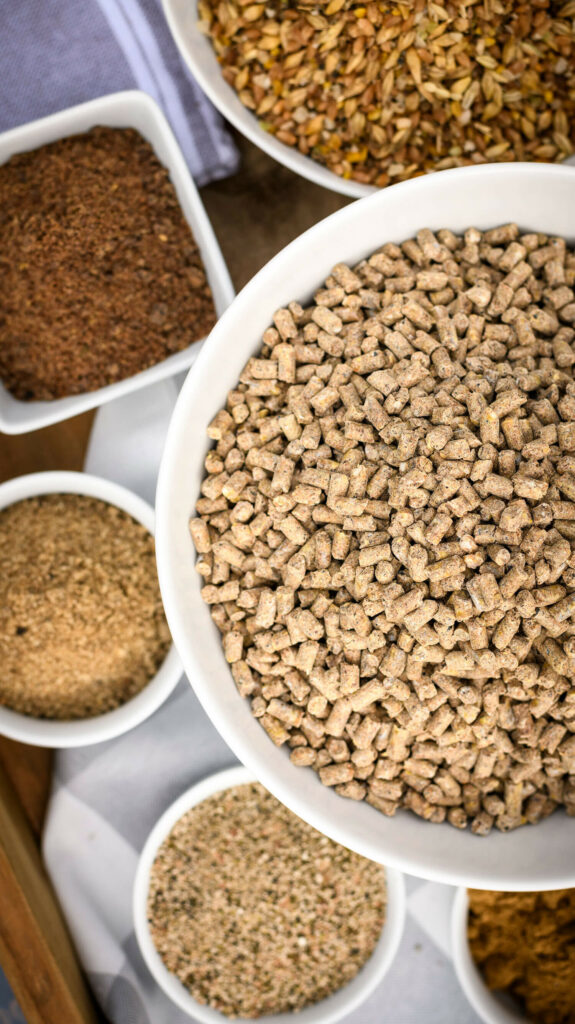Layer mash is a complete feed formulated for laying hens, typically started around 18–20 weeks of age or at first egg, with the protein, energy, vitamins, and extra calcium hens need to lay strong-shelled eggs consistently.
It’s the same balanced nutrition you’ll find in layer pellets or crumbles, but in a mash (loose, coarse-ground whole-grain) format that some flocks digest more comfortably and many keepers prefer for fermenting. Starting layer feeds at point of lay matters: younger, non-laying birds shouldn’t get high-calcium diets.
Example “feed tag” snapshot (typical for a quality layer mash):
- Crude Protein: ~16%
- Calcium: ~3.5–4.5%
- Phosphorus: ~0.4–0.6%
- Form: Mash (can be fed dry, moistened, or fermented)
- Use: Complete ration for laying hens 20+ weeks
(Always read the actual tag on your bag for exact specs.)
What Makes Up Layer Mash?
Core ingredients (vary by brand): whole grains (e.g., wheat, barley), plant or marine proteins, calcium sources (oyster shell/limestone), plus a vitamin–mineral premix.
- Protein (about 16-18%) supports muscle maintenance, feather condition, and steady egg output.
- Calcium (about 3–5%) is critical for shell strength and the hen’s long-term bone health. Hens not yet laying need far less calcium (~1%), which is why timing the transition matters.
- Phosphorus & trace minerals (e.g., manganese, zinc, selenium) help with shell formation, metabolism, and immunity.
Vitamins A, D3, E & B-complex cover growth, shell calcification, and overall vitality.
Average nutrient composition (guideline):
| Nutrient | Typical Range (Layer Mash) |
| Crude Protein | 15–18% |
| Calcium | 3.0–5% |
| Available Phosphorus | 0.4–0.6% |
| Methionine (min) | 0.3–0.4% |
| Lysine (min) | 0.6–0.8% |
These ranges align with university and extension guidance for layers; always check your chosen brand’s tag for exact numbers.
Benefits of Feeding Layer Mash
- Stronger shells: Higher calcium supports shell quality and hen health. Free-choice oyster shell can help high producers.
- Steady laying: Balanced protein, energy, vitamins, and minerals stabilize production.
- Digestibility: Mash’s loose texture can be easier for some birds and is ideal if you ferment feed for improved nutrient availability and natural probiotics.
Flexible mixing: The format makes it simple to incorporate approved supplements (grit and oyster shell offered free-choice).
When to Start Feeding Layer Mash
- Timing: Switch at 18–20 weeks or at the first egg, whichever comes first.
- Readiness signs: Reddening, enlarging combs/wattles; squatting behavior; first eggs.
- Don’t start too early: Excess calcium before point-of-lay can stress kidneys and harm developing birds.
Quick transition guide:
Starter Mash (chicks 0-8 weeks; ducklings 0-4 weeks) -> Grower Mash (pullets 8-20 weeks; ducks 4-20 weeks) → Gradual mix (50/50 for 3–5 days) → Full layer mash + free-choice oyster shell & grit.
Read More Here: How to Feed Your Laying Hens
Layer Mash vs. Other Poultry Feeds
| Form | What It Is | Pros | Cons | Best For |
| Layer Mash | Loose, coarse-ground whole grains | Great for fermenting; some birds prefer texture; easy to mix in supplements | Can be messier if feeders allow billing-out | Keepers who ferment or prefer visible whole grains |
| Layer Pellets | Mash formed into firm “bites” | Less waste; more uniform bite per peck | Some birds dislike texture; extra processing | Flocks that scatter mash; auto-feeders |
| Layer Crumbles | Pellets broken smaller | Easier for smaller beaks; still relatively uniform | Slightly more processing than mash | Mixed-age layer flocks, bantams with smaller beak size |
Pelleting often reduces feed wastage and improves uniformity; crumbles are simply pellets broken down. Mash remains popular with small flocks and fermenters.
How to Feed Layer Mash Correctly
- Daily amount: Plan on ~0.25 lb (4 oz / 100–150 g) per hen per day, adjusting for breed, weather, and free-range time.
- Schedule: Free-choice access or fill feeders once or twice daily; hens graze throughout the day.
- Keep it clean & dry: Use covered troughs or hanging feeders to limit billing-out and moisture; remove wet feed promptly.
Scraps: Limit scratch/kitchen scraps to avoid diluting nutrition (aim for ≤10% of daily intake).
Storage and Shelf-Life Tips
- Keep cool & dry: Store in rodent-proof bins off the floor; avoid excess heat and humidity.
- Shelf-life: Whole-grain layer mash typically keeps up to 9 months if stored properly (check your bag’s date).
- Check freshness: Discard feed that smells rancid, is moldy, clumpy, or buggy.
Common Mistakes to Avoid
- Feeding layer mash to chicks or growers: Too much calcium too early can cause kidney issues; stick with starter/grower until point of lay.
- Overfeeding or sloppy feeders: Increases waste and attracts pests—choose appropriate feeders and monitor intake.
- Ignoring ingredient quality: Read the tag; know your brand.
- Switching abruptly: Blend old and new feed over several days.
How to Check Layer Mash Quality Before Buying
- Look for reputable certification & brand standards (e.g., USDA Organic, Non-GMO Project Verified, Animal-Welfare Certified, North-American grown).
- Smell & appearance: Fresh grain aroma; no musty or chemical smells; color consistent; not overly dusty.
- Texture: Even mash grind; no signs of moisture clumping.
- Retailer: Buy from stores with good turnover (local co-ops, feed stores) to ensure freshness.
Our Layer Mash
Organic Layer Mash 16% is a whole-grain, soy- and corn-free complete feed for chickens and ducks 20+ weeks. Feed dry, moistened, or fermented—whichever fits your routine.
Guaranteed analysis includes ~16% protein and ~3.9–4.9% calcium to support steady production and strong shells, and we recommend free-choice oyster shell and layer grit alongside clean, fresh water.
Shelf-life is up to 9 months when stored properly. (Always follow your bag’s tag.)
- Certified USDA Organic and Non-GMO Project Verified standards across our feed line
- Whole-grain ingredients you can see
- Ferment-friendly for extra bioavailability
- Animal-Welfare certified
- All grains grown in North America; support North American farmers
Explore Layer Pellets and Layer Crumbles too if your flock prefers those formats.
Why Choose Organic Layer Mash
Choosing organic layer mash is about more than what’s not in the bag—it’s about what you’re actively supporting in your birds and on the land.
- Certified standards you can trust. USDA Organic and Non-GMO verification mean no genetically engineered ingredients and no synthetic pesticides or fertilizers in the grains we use.
- Nutrition you can feel good about. A complete, balanced ration formulated for point-of-lay hens to support steady production and strong shells—without unnecessary fillers.
- Better for your system, start to finish. Organic farming practices help protect soil and waterways; feeding organic keeps your flock aligned with those same values.
- Consistent by design. Each bag is formulated to meet known nutrient targets for layers, reducing guesswork and helping you keep hens on track through seasons and molting cycles.
- Ferment-friendly. Mash is easy to ferment for improved palatability and bioavailability—an option many keepers love for gut health and feed efficiency.
Explore our Organic Layer Mash 16% to see ingredients and guaranteed analysis.
Why Whole Ingredients (vs. By-Products Like “Middlings”)
We believe in whole, recognizable ingredients you can see. Here’s why that matters:
- Transparency in every scoop
- Whole grains and clearly listed inputs make it easy to understand what your hens are eating.
- Nutrient integrity
- Minimally processed grains help preserve natural oils, fiber, and micronutrients that support overall health and egg quality.
- Natural eating behavior
- The varied particle size of mash encourages pecking and gizzard development—how birds are built to eat.
- Steady formulation, fewer surprises
- By-products (like wheat “middlings”) can vary batch to batch; whole-ingredient formulas aim for predictable nutrition day after day.
- Great for mixing and fermenting
- Whole and coarsely ground components take well to fermenting and blend smoothly with free-choice oyster shell and grit—no heavy dusting or clumping when handled and stored properly.
If you value quality feed = quality eggs, whole-ingredient layer mash is a straightforward way to align your daily care with your flock’s long-term health. When you’re ready, our Organic Layer Mash 16% is a solid place to start.
Homemade Layer Mash Recipes
If you’re experienced with poultry nutrition, a simple 5–6 ingredient mix (e.g., whole grains + plant/marine protein + mineral/vitamin premix + calcium) can work.
But matching protein, calcium, and micronutrient targets consistently at home is challenging, especially across seasons and breeds.
Commercial feeds are formulated to meet established requirements—reducing guesswork and risk.
Rule of thumb if you DIY:
- Target ~16% protein, ~3.5–5% calcium, and appropriate phosphorus/trace minerals; include a poultry vitamin–mineral premix.
- Track eggshell quality and production; adjust cautiously.
- When in doubt, choose a complete commercial feed to avoid deficiencies.
University and extension guidelines are a helpful reference point for nutrient targets and timing.
Final Thoughts on Layer Mash
Layer mash is a nutrient-dense, point-of-lay feed that supports shell strength, steady production, and overall hen health. Start around 18–20 weeks (or first egg), offer oyster shell and grit free-choice, and keep feed clean, dry, and fresh.
Pair good nutrition with clean water, adequate space, and safe housing—and track egg output after switching to confirm your flock is thriving.
Want the details in one place? Grab your bag of Organic Layer Mash 16% and check the tag, we’ve done the math so your laying ladies can do their best work.
